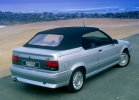Test drive by Renault 19 Cabrio 1992 - 1996 hatchback
11 to 12
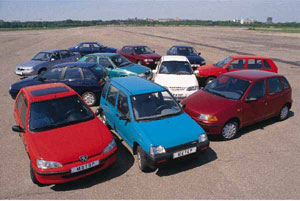 The collection was announced on the Khodynsky field. When all eleven were already in place, black Tahoe rolled up. The driver went out, walked between the cars. And he said: so guys. I have that, for my wife. To whom to give the money?
The collection was announced on the Khodynsky field. When all eleven were already in place, black Tahoe rolled up. The driver went out, walked between the cars. And he said: so guys. I have that, for my wife. To whom to give the money? 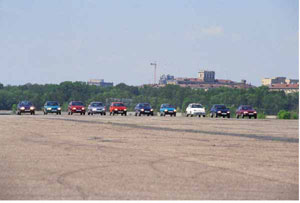 If a citizen buys any product in general and a car in particular, he has the right to count, at least, that the problems will not arise immediately during its operation. As for the car, besides this, I want to enjoy its driving. Therefore, our citizen (the one who can already afford it), of course, turns his eyes to foreign cars. And for a considerable amount for him, he already wants to have a decent guarantee, and a good service, and certified spare parts.
If a citizen buys any product in general and a car in particular, he has the right to count, at least, that the problems will not arise immediately during its operation. As for the car, besides this, I want to enjoy its driving. Therefore, our citizen (the one who can already afford it), of course, turns his eyes to foreign cars. And for a considerable amount for him, he already wants to have a decent guarantee, and a good service, and certified spare parts. 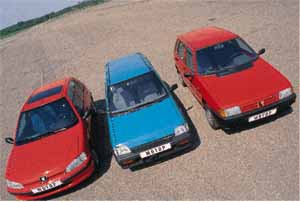 By selecting cars for a comparative test, we were guided by two rigid criteria - the retail price (up to $ 12,000) and the presence of official dealers (and therefore the possibilities of corporate service). Some potential participants drove past due to the price (Ford Escort, Nissan Micra), some due to sulfur (Subaru Vivio and Rover Montero of the Bulgarian assembly). But even without them, there were enough cars - eleven!
By selecting cars for a comparative test, we were guided by two rigid criteria - the retail price (up to $ 12,000) and the presence of official dealers (and therefore the possibilities of corporate service). Some potential participants drove past due to the price (Ford Escort, Nissan Micra), some due to sulfur (Subaru Vivio and Rover Montero of the Bulgarian assembly). But even without them, there were enough cars - eleven! 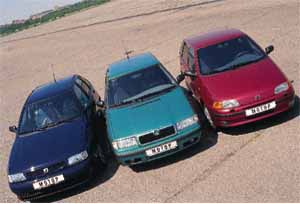 We were not embarrassed that all the cars were already tested by the motor at one time. Entering the second circle, we knew that in two years a lot of water flowed - some models were updated, and some, which passed the test in winter,, among other things, was interesting to try in the summer.
We were not embarrassed that all the cars were already tested by the motor at one time. Entering the second circle, we knew that in two years a lot of water flowed - some models were updated, and some, which passed the test in winter,, among other things, was interesting to try in the summer. 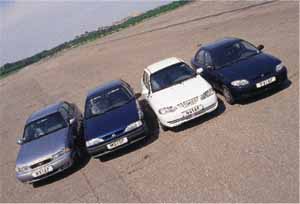 So, 11 cars worth from $ 5,000 to $ 12,000. For correctness, we divided them into four subspecies: compact hatchbacks with low-power motors up to 1.0 liters (41-50 hp); The same thing, but with powerful engines-1.2-1.6 liters (60-75 hp); Compact sedans (75-90 hp) and a Golf class (and it turns out, it happens for this price).
So, 11 cars worth from $ 5,000 to $ 12,000. For correctness, we divided them into four subspecies: compact hatchbacks with low-power motors up to 1.0 liters (41-50 hp); The same thing, but with powerful engines-1.2-1.6 liters (60-75 hp); Compact sedans (75-90 hp) and a Golf class (and it turns out, it happens for this price). 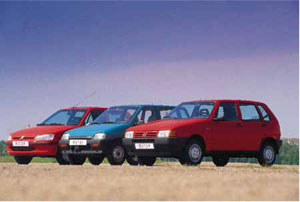 Let's start with a small one: Daewoo Tico - Fiat Uno - Peugeot 106. Daewoo Tico is produced in Uzbekistan, Fiat UNO - in Poland, Peugeot 106 - in France. Typical city car carriers, designed for the torn rhythm of urban intersections and a crowd in traffic jams, and not for family cruising runs Moscow - Crimea. They are enough to carry 1-2 people on business.
Let's start with a small one: Daewoo Tico - Fiat Uno - Peugeot 106. Daewoo Tico is produced in Uzbekistan, Fiat UNO - in Poland, Peugeot 106 - in France. Typical city car carriers, designed for the torn rhythm of urban intersections and a crowd in traffic jams, and not for family cruising runs Moscow - Crimea. They are enough to carry 1-2 people on business. Daewoo Tico
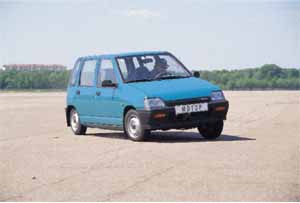 Danas: the steering wheel is slightly hard to the touch, but convenient in size; Skinny lever of the box with fast and comfortable handling of gears; Light informative pedals and a large speedometer circle.
Danas: the steering wheel is slightly hard to the touch, but convenient in size; Skinny lever of the box with fast and comfortable handling of gears; Light informative pedals and a large speedometer circle. A compact 3-cylinder motor, the sound of which during operation resembles a muffled screech of a chainsaw, removes 6.5 centners of the car without tension and approximately a centner of the driver. The salon against the background of the external size of Tico seems large than it really is. Inside TICO can accommodate 4 1/2 riders, of which the rear 2 1/2 is not breathing. The doors when slamming are published with tin rattles, all the seats are flat and hard, sheathed with gray vinyl - the Uzbek standard. The trunk is as symbolic as the brotherhood of the two peoples - Russian and Uzbek. All this costs $ 5,000. To whom it seemed little - it can choose the top -tico: with velor and air conditioning in the cabin. From this, the car will rise in price by exactly 10%.
Speaking of air conditioners. Small engines (and all 11 cars are equipped with such) do not have a sufficient supply of power necessary for the air conditioner and the simultaneous maintenance of passport dynamic characteristics of the car. In other words, the coolness in the cabin is achieved due to the noticeable dullness of the motor and a significant (up to 10-15%) increase in fuel consumption. An acceptable, that is, not particularly affecting dynamics and efficiency, is considered to be installed an air conditioner on cars with engines with a working volume of 1.8 liters or more.
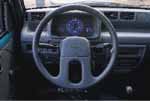 The three -cylinder Daewoo is quite full as a vehicle for a metropolis. Moreover, the maximum effect can be achieved precisely during peak hours, when the whole city stands, and you are going. Tico, thanks to its size, has amazing maneuverability and rotaryness. The power on the steering wheel is minimal, despite the lack of hydraulic power. Review in all directions and mirrors is excellent.
The three -cylinder Daewoo is quite full as a vehicle for a metropolis. Moreover, the maximum effect can be achieved precisely during peak hours, when the whole city stands, and you are going. Tico, thanks to its size, has amazing maneuverability and rotaryness. The power on the steering wheel is minimal, despite the lack of hydraulic power. Review in all directions and mirrors is excellent. The maximum speed on the highway is 130 km/h. Faster - only under the hill or with a blessed hurricane wind. Naturally, such a light machine is affected by external forces, such as the irregularities of the road or the lateral wind. Nobody was particularly engaged in the body of the body with a body aerodynamics. As a result - a lot of sailing. Graving a side wind at speed, Tico can easily play aside. A comfortable speed threshold is at an mark of 100-110 km/h. Do not expect from this machine an increased passive safety and the vitality of the suspension. To reduce shock loads, full -profile dimensions of 135 R12 are used.
We must pay tribute to the engine - it is enough for a hundred meter of acceleration. With one driver on board Tico leaves as easily as empty vases. With a complete load of the car, you can be glad that it is still going.
The controllability of the car is predictable, like the front -wheel drive bicycle (remember your first children's fox with pedals under the wheel?). The main thing is not to slip and have time to skip the wheels between bumps and holes.
Fiat uno
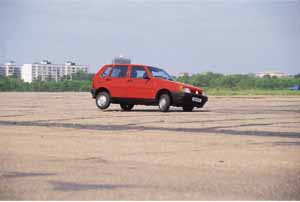 A simple, well-sewn and not devoid of grace car of development of 15 years ago. During external examination, no visible flaws were found. Conducted regular plastic lins in the arches of the front wheels and additional anti -corrosion protection of the thresholds.
A simple, well-sewn and not devoid of grace car of development of 15 years ago. During external examination, no visible flaws were found. Conducted regular plastic lins in the arches of the front wheels and additional anti -corrosion protection of the thresholds. The simple plastic plastic of the dashboard once again emphasizes the utilitarianism of the machine. In the same spirit, the interior decoration is also performed. True, we must pay tribute to his non -recycling - in the movement the elements of the salon remain silent.
The driver’s landing is adjusted in a wide range, and even with a growth of eighty -five meter, you can feel quite comfortable. Naturally - due to the rear passengers. The ergonomics of the workplace will not upset the person who has moved to UNO from a modern car. The absence of any side support of the seats is partially compensated by the villous material of the seat upholstery and the close location of the door of the door - in extreme cases, there will be something to rest. There are three steering wheel levers - as in classic Lada. Light control is separated from the turn signal switch. Mirrors are adjusted manually, but from the cabin. The steering column is not adjustable. I would like to pay attention to the presence of headlights in the standard configuration of hydraulic corrector.
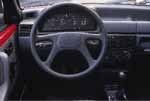 Go. From a car with a liter engine, in general, you do not expect special agility. But in fact, UNO is quite frisky. In the stream, the car holds easily and confidently. The suspension is quite rigid, which made it possible to achieve the necessary strict control without the use of complex technical solutions. Polish UNO in the standard is equipped with tires of the same size as Tico - 135 R12.
Go. From a car with a liter engine, in general, you do not expect special agility. But in fact, UNO is quite frisky. In the stream, the car holds easily and confidently. The suspension is quite rigid, which made it possible to achieve the necessary strict control without the use of complex technical solutions. Polish UNO in the standard is equipped with tires of the same size as Tico - 135 R12. Tachometers in Tico, UNO and 106th Peugeot are absent as a class. They really do not need anything - with a very conditional sound insulation of motor compartments, any more or less experienced driver is capable of, if not to feel, then at least hear the engine of the engine.
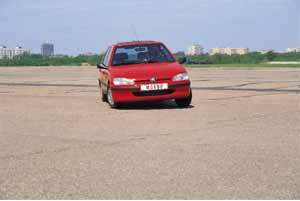 PEUGEOT 106
PEUGEOT 106 Instead of a tachometer - a hefty watch! This is the first thing you pay attention to when getting into the salon. As for the front of the cabin, with its ergonomics and comfort, Peugeot is noticeably different from the presented classmates. Seats with good lateral support and profiled emphasis of the lower back. The elegant and laconic front panel is made of soft plastic. The steering wheel is pleasant in girth. A minimum of buttons - they are all under the right hand on the central console. Nothing interferes with visibility. External mirrors are especially good. With their small sizes, they provide viewing angles, as they say, with a margin. At the back - as in the two previous cars - comfort is relative. There is where to sit down, put the feet too. But where to put your knees?
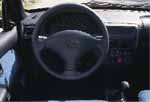 In order for the acceleration dynamics to be more fun, it is necessary to get comfortable with the gas-gaze pedal and the space allotted for the right leg. In addition, it would be nice to learn how not to touch the lower edge of the torpedo when squeezing the clutch. The suspension is moderately tough. The steering wheel is sharp, without delay. In quick alternating turns, a noticeable diagonal roll is observed, which can go into hiding the rear wheels, but at the same time the machine has a decent reserve for the clutch of the wheels in the lateral direction. On the 106th, you are not afraid of a car that suddenly slowed down in front of you, nor any boat cut off your baby-the steering wheel and brakes will not fail.
In order for the acceleration dynamics to be more fun, it is necessary to get comfortable with the gas-gaze pedal and the space allotted for the right leg. In addition, it would be nice to learn how not to touch the lower edge of the torpedo when squeezing the clutch. The suspension is moderately tough. The steering wheel is sharp, without delay. In quick alternating turns, a noticeable diagonal roll is observed, which can go into hiding the rear wheels, but at the same time the machine has a decent reserve for the clutch of the wheels in the lateral direction. On the 106th, you are not afraid of a car that suddenly slowed down in front of you, nor any boat cut off your baby-the steering wheel and brakes will not fail. In the near future, the Russian market for compact models should be activated. By the fall, official sales of Ford KA will begin. The car has already been certified in Russia. The machines arriving to us will be equipped with an enhanced suspension and increased to 156 mm (against ordinary 140) road clearance. The price of Ford KA is already announced - from $ 11.500 (standard) to $ 13.500 (with air conditioning and electric packet). No later than next year, Hyundai and Daewoo will also present their smallest models with 3 -cylinder engines in Russia - ATOS and D'Ars, respectively. The prices for them, given the offer of competitors, are unlikely to exceed $ 8000. At the same time, the production of Daewoo Tico in Uzbekistan will continue.
Specifications
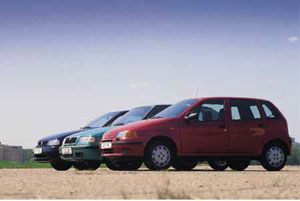 Seat Ibiza can be called the cousin of Czech Czech Skoda Felicia, referring not so much that both brands belong to the Volkswagen concern, but that both machines have platforms developed by Fiat engineers. The Ibiza platform was created in 1984, when the Spanish plant still belonged to Italians. Some nodes were unified with Fiat Uno and Ritmo models. About the same with Skoda Felicia: its platform is essentially a predecessor model - Favorit, which in turn also has Italian roots: back in the early 80s, the Czechoslovakia government bought one of Fiat Uno's competitive selection of Fiat Uno projects . The latter was destined to become Skoda Favorit in 1984. Thus, all three compact hatchbacks are relatives.
Seat Ibiza can be called the cousin of Czech Czech Skoda Felicia, referring not so much that both brands belong to the Volkswagen concern, but that both machines have platforms developed by Fiat engineers. The Ibiza platform was created in 1984, when the Spanish plant still belonged to Italians. Some nodes were unified with Fiat Uno and Ritmo models. About the same with Skoda Felicia: its platform is essentially a predecessor model - Favorit, which in turn also has Italian roots: back in the early 80s, the Czechoslovakia government bought one of Fiat Uno's competitive selection of Fiat Uno projects . The latter was destined to become Skoda Favorit in 1984. Thus, all three compact hatchbacks are relatives. Skoda Felicia
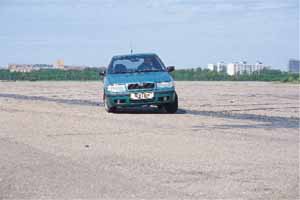 Updated, or, as they say, aged Felicia with a more powerful Volkswagen 1.6 (75 hp) engine for $ 11.200 has every chance of becoming a triumph among compact hatchbacks in the Russian market. Simply, but with taste - this definition is the best suited to Felicia 1.6. The symbiosis of the Czech shell and the German filling allowed to get an extremely nimble and pleasant car control. The elastic motor is perfectly pulling in the entire range and very briskly carries a light car from the traffic light, and small dimensions facilitate the parking and urban slalom. The steering wheel without hydraulic power, the pedal is very soft, and the box lever has small moves and a clear fixation. Thanks to easy steering with good feedback, the car responds well to any steering manipulations and always remains controlled.
Updated, or, as they say, aged Felicia with a more powerful Volkswagen 1.6 (75 hp) engine for $ 11.200 has every chance of becoming a triumph among compact hatchbacks in the Russian market. Simply, but with taste - this definition is the best suited to Felicia 1.6. The symbiosis of the Czech shell and the German filling allowed to get an extremely nimble and pleasant car control. The elastic motor is perfectly pulling in the entire range and very briskly carries a light car from the traffic light, and small dimensions facilitate the parking and urban slalom. The steering wheel without hydraulic power, the pedal is very soft, and the box lever has small moves and a clear fixation. Thanks to easy steering with good feedback, the car responds well to any steering manipulations and always remains controlled.  Standard, in relation to this model - naked, equipment. What do we see? The salon is simple, without excesses. The upholstery of doors and seats is continuous textiles, gray and motley. Hardy seats with good lateral support, stripping from the door to a distance that does not allow to lean or lean on the latter. Two standard adjustments to the driver's seat. The landing is high. Review does not cause complaints. Safety belts are adjustable in height. All windows are mechanical, their handles are located conveniently and do not require much effort in work. There are no electric locks of locks. The driver feels freely: the car is wide enough and does not press in the shoulders, but a slightly smaller steering wheel interferes with the knees and makes control in sporting sharp. The rear passengers of high growth are interfering with the ceiling and front seats. The sofa, designed for 2 and 1/2 passengers, is slightly profiled and equipped with headrests. Three large suitcases will fit in the trunk.
Standard, in relation to this model - naked, equipment. What do we see? The salon is simple, without excesses. The upholstery of doors and seats is continuous textiles, gray and motley. Hardy seats with good lateral support, stripping from the door to a distance that does not allow to lean or lean on the latter. Two standard adjustments to the driver's seat. The landing is high. Review does not cause complaints. Safety belts are adjustable in height. All windows are mechanical, their handles are located conveniently and do not require much effort in work. There are no electric locks of locks. The driver feels freely: the car is wide enough and does not press in the shoulders, but a slightly smaller steering wheel interferes with the knees and makes control in sporting sharp. The rear passengers of high growth are interfering with the ceiling and front seats. The sofa, designed for 2 and 1/2 passengers, is slightly profiled and equipped with headrests. Three large suitcases will fit in the trunk. Under the pricing bar $ 12,000, not only the standard hatchback passes calmly, but also the Felicia Combi station wagon with a 1.3 engine (55 hp).
Seat Ibiza
 In our opinion and taste, Ibiza (second -generation model) is the most stylish and original car of all presented here. It is impossible to confuse the car with any other - thanks to the long front and very short rear overhang of the body. For five years of release, the design from the ITALDESIGN studio is not outdated ...
In our opinion and taste, Ibiza (second -generation model) is the most stylish and original car of all presented here. It is impossible to confuse the car with any other - thanks to the long front and very short rear overhang of the body. For five years of release, the design from the ITALDESIGN studio is not outdated ... There are no complaints about the combination of devices, the steering wheel and the pedal unit. Front velor seats - with good lateral support. The salon, however, is somewhat crowded. Volkswagen 1.4 - 60 horses: exactly the same is installed on Polo.
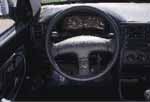 In the car, the hand of a German mentor is felt - Ibiza is noticeably standing out against the background of other cars with the quality of manufacture and assembly of both the car as a whole and its salon. The materials are carefully selected, and the details create the impression of a whole with their adjustment. The work of the driver facilitates the anti -spool coating of the torpedo - in the spirit of the latest trends in the automotive industry. I would only like to raise the steering wheel a little and make the salon more spacious.
In the car, the hand of a German mentor is felt - Ibiza is noticeably standing out against the background of other cars with the quality of manufacture and assembly of both the car as a whole and its salon. The materials are carefully selected, and the details create the impression of a whole with their adjustment. The work of the driver facilitates the anti -spool coating of the torpedo - in the spirit of the latest trends in the automotive industry. I would only like to raise the steering wheel a little and make the salon more spacious. I must say that in a year and a half, which passed since our first acquaintance with her, the car became noticeably stricter, pulled up, lethargy and uninformativity of pedals have disappeared, and the drive of the gearbox has gained the necessary clarity and accuracy.
The Ibiza dynamics is located on a good level for this class and can serve as a standard for the test participants. Manageability was also one of the best. The car holds the road perfectly and sensitively reacts to the turns of the steering wheel and the position of the gas pedal. The car is easily and obediently shifted from side to side, while even on a decent rear wheel drive for such maneuvers, one should not be afraid of the rear wheels. Brakes - without ABS, however, they stop the car reliably and quickly.
Fiat Punto
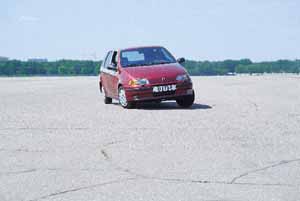 Ferrari is also Fiat, and we joyfully tuned in at a sports and dynamic way. As it turned out, in vain: Fiat Punto is a mass car. Pretty sluggish dynamics does not give a feeling of freedom and speed when changing the lanes: you have to twist the engine all the time, and this is with an almost empty car. The programs are very stretched, which, combined with the motor features, makes a speed set of over 80 km/h with a very tedious occupation, and does not tear from the place of Punto ...
Ferrari is also Fiat, and we joyfully tuned in at a sports and dynamic way. As it turned out, in vain: Fiat Punto is a mass car. Pretty sluggish dynamics does not give a feeling of freedom and speed when changing the lanes: you have to twist the engine all the time, and this is with an almost empty car. The programs are very stretched, which, combined with the motor features, makes a speed set of over 80 km/h with a very tedious occupation, and does not tear from the place of Punto ...  The steering wheel is the same as acceleration - sluggish and weak -shaped. A large delay of the car to the turns of the steering wheel causes bewilderment and surprise, as well as questions like whether it is too big backlash in the rail or whether the hole in the wheel. Everything turned out to be in order with rubber, in the bend it holds the car well, and the gap in the steering mechanism in statics within normal, just the whole car is some kind of jelly-like. There is a clear overkill of softening circumstances, including the characteristics of the suspension, which differs in large moves. In general, there is no hot blood here.
The steering wheel is the same as acceleration - sluggish and weak -shaped. A large delay of the car to the turns of the steering wheel causes bewilderment and surprise, as well as questions like whether it is too big backlash in the rail or whether the hole in the wheel. Everything turned out to be in order with rubber, in the bend it holds the car well, and the gap in the steering mechanism in statics within normal, just the whole car is some kind of jelly-like. There is a clear overkill of softening circumstances, including the characteristics of the suspension, which differs in large moves. In general, there is no hot blood here. In one group with Felicia, Ibiza and Punto, one could also turn on the Kia Pride with a 1.3 engine (64 hp), but the supply of this model to Russia is one -time and unprofitable. The only (five Moscow) Kia dealer specializing in the Pride does not even know when the next batch arrives. And so this car (Licensed Copy of Mazda 121) complete with air conditioning and for $ 9900 could make up the most severe competition Felicia 1.3. But what is not - that is not.
Hyundai also offers a gamut of compact hatchbacks. Three- and five-door accents with a 75-horsepower engine are laid in $ 12,000 only in bare form. Since the Accent in our test is with the sedan body, we note in absentia that due to the short and, therefore, the lighter rear history of the hatchback of this model have better stability in the bend and allow more active control. However, for the same reasons, they are inferior to the same sedan in the smoothness of the course and course stability in the line.
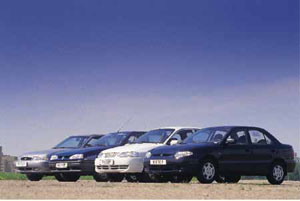 We deliberately attributed Daewoo Nexia and Renault 19 to compact sedans, and not to the Golf class, as they were interpreted earlier. Yes, at one time, the Renault 19 hatchback and the German prototype Nexia were not only classmates, but also the most dense VW Golf competitors. But over the past 10 years, Golf, and therefore the entire class equal to it has grown in all dimensions - outside and inside. And Nexia and Renault 19 remained with their dimensions, and they no longer correspond to the modern GOLF class. In addition, the sedan is still more correct to compare with the sedan. If our arguments seem unconvincing to you, then compare these cars not with a short Golf, but with VW Vento. The difference will be noticeable, as they say, with the naked eye.
We deliberately attributed Daewoo Nexia and Renault 19 to compact sedans, and not to the Golf class, as they were interpreted earlier. Yes, at one time, the Renault 19 hatchback and the German prototype Nexia were not only classmates, but also the most dense VW Golf competitors. But over the past 10 years, Golf, and therefore the entire class equal to it has grown in all dimensions - outside and inside. And Nexia and Renault 19 remained with their dimensions, and they no longer correspond to the modern GOLF class. In addition, the sedan is still more correct to compare with the sedan. If our arguments seem unconvincing to you, then compare these cars not with a short Golf, but with VW Vento. The difference will be noticeable, as they say, with the naked eye. Today, Nexia and Renault 19 are collected away from the homeland. Nexia - in Rostov -on -Don and Uzbekistan (we took Rostov), \u200b\u200band Renault 19 in Turkey. To them we attached Hyundai Accent and Kia Avella Delta a native Korean assembly.
As you know, Kia Avella Delta has been collected in Kaliningrad for more than a year, and the Hyundai Accent assembly is about to begin in the Saratov region and Kazakhstan. Today, Kaliningrad Avella is cheaper than native by $ 1000. The Korean version of the 1998 Avella model year can be found in the stream by a new cellular front grill and a modified form of the rear lights. This car has not undergone other changes over the past year.
Uzbek Nexia costs an average of $ 900 cheaper than Rostov. At first glance - the difference in bumers: in Rostov, they are painted in the color of the body, and in Uzbek - just black. If you dig deeper, then technologically Daewoo from Rostov-on-Don is closer to the original-only assembly is conducted in the workshops of the former combine plant, and components, including bodies, are supplied from Korea. The Uzbeks do everything themselves: stamp, weld, stain and collect.
According to the combination, price-quality (and quantity!) Nexia cars in Russia look preferable to many Togliatti models. So thanks to Nexia, Daewoo became the leader (among foreign companies) for sales in the Russian market, selling a total of 18.500 cars last year - more than two times the closest opponent - Skoda.
Daewoo Nexia
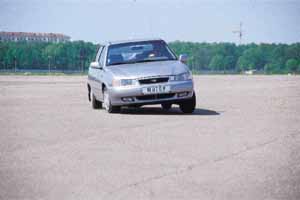 Since our first acquaintance (Motor E3, 1996), nothing has changed in the car. In addition to the price: at that time Nexia cost $ 16.500, today it is possible to become its owner by paying 5, or even 6 thousand less.
Since our first acquaintance (Motor E3, 1996), nothing has changed in the car. In addition to the price: at that time Nexia cost $ 16.500, today it is possible to become its owner by paying 5, or even 6 thousand less. Compared to classmates, the car seemed more convenient for both the driver and passengers. In any case, there is a lot of free space in front and behind, there is no discrimination of tall passengers. Front seats inhabited by gray fabric have good side support not only on the back, but also on the pillow. The angular shape of the instrument panel returns us during the queues for sausage. Today, rarely anyone recalls that in their original state Nexia is an Opel Kadett model of 1987, a real German car. Therefore, despite the anachronism of some details of the cabin (subsequent modifications did not affect the interior), this model still meets modern ideas about ergonomics.
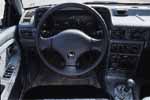 There are no comments on the location of the devices and buttons. Devices are read from one glance. Functions management are displayed under the right hand. Windows and door locks - electric, the drive of the mirrors, however, is mechanical. On the torpedo is a large shelf for any little things. Under the windshield - an electronic clock. If you do not compare Nexia with younger classmates, then we can say that inside it looks like a completely modern model with a certain degree of conservatism in design.
There are no comments on the location of the devices and buttons. Devices are read from one glance. Functions management are displayed under the right hand. Windows and door locks - electric, the drive of the mirrors, however, is mechanical. On the torpedo is a large shelf for any little things. Under the windshield - an electronic clock. If you do not compare Nexia with younger classmates, then we can say that inside it looks like a completely modern model with a certain degree of conservatism in design. The only ergonomic inconvenience occurs when landing on the back row - the opening between the seat pillow and the central persistent narrow. The leg has to be literally widened, pulling down the foot. However, what Koreans bought, they sell - Nexia inherited a lot from Opel Kadett, including disadvantages.
There are disadvantages in the assembly - for a long time not German and no longer Korean. The jamming tensioner, for example, resisted attempts to pull the seat belt for a long time.
The acceleration dynamics of Daewoo Nexia is not impressive, but even acceleration leaves a good impression. Soft suspension and high tires provide excellent smoothness of the course and, unlike the similarly shod Kia Avella delta, affect the body's roll in the bend slightly. As for controllability, that is, Nexia has a feature that, apparently, can be explained by the selection of rubber. Even before the gliding of the front wheels begins in the bend, the car leads at the slightest irregularities at the entrance. In this case, the force on the steering wheel increases sharply. With its behavior, the car, as it were, warns the driver in advance about the need for a more careful driving.
Over the past 10-12 years, the requirements even for a simple and cheap car have changed towards the possibility of active drive. But the improvement of the characteristics of the engines is not always accompanied by adequate changes in the parameters of suspensions and steering, which we have seen. It’s good that the brakes developed 15 years ago is enough.
Hyundai Accent
 Once we wrote that we almost love this car. Indeed, a pleasant dynamic machine with a cheerful appearance, with a slight correctness in turning ... But a sedan with a 1.3 -liter engine fell into our hands for the first time. And the attitude to this model has changed somewhat ...
Once we wrote that we almost love this car. Indeed, a pleasant dynamic machine with a cheerful appearance, with a slight correctness in turning ... But a sedan with a 1.3 -liter engine fell into our hands for the first time. And the attitude to this model has changed somewhat ... Firstly, the dynamics of Accent 1.3 no longer shines - the mass that has increased in relation to power affects. The reaction to the gas pedal is somewhat cotton. It takes some time before the engine responds to a sharp opening of the throttle. However, it is unlikely that a sedan with such a motor is designed for active driving - the Hyundai gamma offers a light hatchback or a sedan with a 90 -horsepower 1.5 liter engine for this. The main trump cards of the sedan 1.3 - a more spacious interior and low price (1.5 -liter versions are more expensive than $ 12,000).
Having dealt with the dynamics, we regretted that strict suspension and effective brakes of Accent disappear idle. Naturally, there can be no question of any reconnaissance under the calm temperament of the car in this case - the characteristics of the suspension and brakes correspond to more powerful versions. But if you really want to energize beautifully, then you can do this with such a motor, you only need to twist it properly.
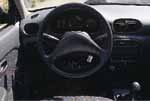 Accent has good maneuverability. The steering is informative. In all modes, the behavior of the car is predictable and rarely requires additional adjustment. An increased load on the rear axle helps to improve controllability. And if the sedan breaks into sliding, then the return to the trajectory will not require much physical tension - the efforts on the steering wheel are minimal.
Accent has good maneuverability. The steering is informative. In all modes, the behavior of the car is predictable and rarely requires additional adjustment. An increased load on the rear axle helps to improve controllability. And if the sedan breaks into sliding, then the return to the trajectory will not require much physical tension - the efforts on the steering wheel are minimal. The landing is convenient, there is a small lateral support. The mutual arrangement of the gearbox lever and the pedal block implies an active driving manner. The low price of the machine can be guessed according to the material of the majority of the interior elements. But the quality of their performance is quite acceptable.
Renault 19
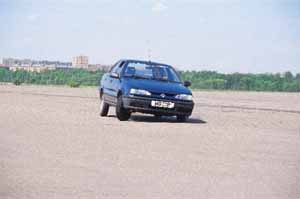 Renault 19 cars during the time since their appearance in our market managed to gain wide popularity. Their main trump cards are simplicity, reliability, unpretentiousness and good anti -corrosion treatment.
Renault 19 cars during the time since their appearance in our market managed to gain wide popularity. Their main trump cards are simplicity, reliability, unpretentiousness and good anti -corrosion treatment. The appearance is uncomplicated, but by no means cheap, but concise and memorable. The salon is simple, but comfortable and little different from the Skoda salon - continuous mechanical adjustments and drives. Upholstery is gray leather and fabric. Sitting is quite convenient and spacious - both in front and behind.
This is not to say that Renault 19 has some outstanding technical characteristics, especially in Turkish - carburetor - performance. The combination of the rear torsion suspension and Macpherson in front provides such softness of the course that some here even motionless. Management, however, is not bad. Despite the absence of a servuselor, steering does not require much effort. Even on a slippery, winding road, Renault 19 is very stable and is reluctant to provocation. When they succeed, everything remains under control and it easily returns to the desired trajectory.
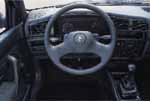 The carburetor, with a manual suction, a 72-horsepower engine of 1.4 liters is quite elastic, but it is impossible to call it a shift. Another thing is a 1.6 -liter engine, but this one costs completely different money.
The carburetor, with a manual suction, a 72-horsepower engine of 1.4 liters is quite elastic, but it is impossible to call it a shift. Another thing is a 1.6 -liter engine, but this one costs completely different money. The dynamics of Renault 19 leaves much to be desired, but given that the described engine is installed on, frankly, a rather big car, we did not expect another. Renault 19 is well held by the steering wheel and gas in the turning path. The suspension swallows irregularities on the road well - a long trip will not be tedious. Brakes - without comments. The pedal force is acceptable for both men and women. The absence of an anti -lock system in this machine, which does not differ in increased dynamic data, is quite natural.
Kia Avella Delta
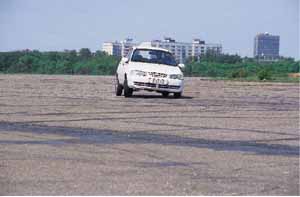 The most equipped of all was the Kia Avella Delta salon. There is a power steering, and an electricrope, and four electric windows, and even ... air conditioning. Unfortunately, not everything is smooth with ergonomics. The inner hands of all doors are too shifted back and, closing the door, resting your elbow on the back of the seat or on the rack. And doing this with the other hand is already completely inconvenient. The windows buttons are under the wrist of the arm lying on the armrest, which is also a minus. Safety belts sticking out on high racks: if there is no passenger ahead, the driver hurts the lock with an elbow.
The most equipped of all was the Kia Avella Delta salon. There is a power steering, and an electricrope, and four electric windows, and even ... air conditioning. Unfortunately, not everything is smooth with ergonomics. The inner hands of all doors are too shifted back and, closing the door, resting your elbow on the back of the seat or on the rack. And doing this with the other hand is already completely inconvenient. The windows buttons are under the wrist of the arm lying on the armrest, which is also a minus. Safety belts sticking out on high racks: if there is no passenger ahead, the driver hurts the lock with an elbow. 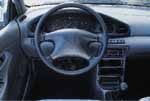 The high, semicircular roof Delta creates a large gap between the head of the driver and the ceiling. Sitting from behind was less fortunate: high passengers almost rest on the top of the ceiling. By the way, about the upholstery. The ceiling located in the center of the cabin is equally available for all passengers, but its toggle switch is located in such a way that the snow -white upholstery is quickly wiped with fingers.
The high, semicircular roof Delta creates a large gap between the head of the driver and the ceiling. Sitting from behind was less fortunate: high passengers almost rest on the top of the ceiling. By the way, about the upholstery. The ceiling located in the center of the cabin is equally available for all passengers, but its toggle switch is located in such a way that the snow -white upholstery is quickly wiped with fingers.  A soft long -speed suspension, coupled with full -profile tires 175/70R13, provide excess, might say, smoothness. True, there were no attacks of marine disease, but this does not mean that such a setting is optimal. In a turn, a roll of comfort and excluding the possibility of active steering occurs in a bend. Due to the cotton characteristics of the hydraulic booster reaction to the driver’s actions, the driver’s actions are somewhat thoughtful, which does not allow to merge with the car.
A soft long -speed suspension, coupled with full -profile tires 175/70R13, provide excess, might say, smoothness. True, there were no attacks of marine disease, but this does not mean that such a setting is optimal. In a turn, a roll of comfort and excluding the possibility of active steering occurs in a bend. Due to the cotton characteristics of the hydraulic booster reaction to the driver’s actions, the driver’s actions are somewhat thoughtful, which does not allow to merge with the car. Kia Sephia
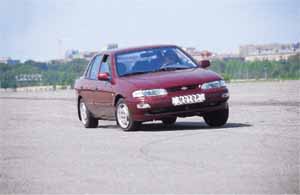 We were a lot surprised when, on the same line with a price of $ 11.500, we read the name Sephia - a sedan of a modern Golf class. This is the largest and most spacious car of all presented here. And if a year ago, Sephia could somehow justify the money invested in it ($ 15,000) only with its appearance, today this car in standard configuration costs its $ 11.500 not only externally, but also internally. Judge for yourself: a 76-horsepower engine with distributed injection, steering wheel, central locking, immobilizer, electric windows, tissue upholstery of seats, adjustment of the driver's pillow in height. The assembly is only Korean.
We were a lot surprised when, on the same line with a price of $ 11.500, we read the name Sephia - a sedan of a modern Golf class. This is the largest and most spacious car of all presented here. And if a year ago, Sephia could somehow justify the money invested in it ($ 15,000) only with its appearance, today this car in standard configuration costs its $ 11.500 not only externally, but also internally. Judge for yourself: a 76-horsepower engine with distributed injection, steering wheel, central locking, immobilizer, electric windows, tissue upholstery of seats, adjustment of the driver's pillow in height. The assembly is only Korean. In just a year, this model has fallen in price by 25% thanks to the reasonable policy of Kia dealers. And, as a result, in the summer of 1998, Sephia is the most affordable and well -purchased Golf Class car in Russia. His closest competitive home-grader, Ford Escort 1.3 CL with a carburetor 65-horsepower engine and equipped with only a central lock, costs $ 1000 more expensive. The appearance of the second generation Sephia has not yet affected the positions of the first. It is not yet heard about removing it from production or transferring the conveyor to third countries.
Sephia LEO hatchback with the same 1.5-liter, one motor is more expensive than a basic sedan. This is due to the higher level of the initial configuration of the hatchback: ABS, two pairs of disk brakes (front - ventilated), two airbags. $ 13,000 enters the circle.
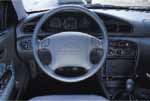 The gray tone of the Sephia interior revives colored fabric inserts on the seats and upholstery of the doors. Devices have large, easily readable scales. All buttons are conveniently located on the central console, and very soon you begin to easily find them to the touch. Music is not included in the standard equipment. It is for the better: acoustics are not very, the radio itself is also so -so ... Besides, the latter lining is perhaps the main source of creaks in the salon. So there is an opportunity to install more advanced equipment.
The gray tone of the Sephia interior revives colored fabric inserts on the seats and upholstery of the doors. Devices have large, easily readable scales. All buttons are conveniently located on the central console, and very soon you begin to easily find them to the touch. Music is not included in the standard equipment. It is for the better: acoustics are not very, the radio itself is also so -so ... Besides, the latter lining is perhaps the main source of creaks in the salon. So there is an opportunity to install more advanced equipment. Chairs of good anatomy and with excellent lateral support. It is difficult to find fault with the convenience of planting. Review does not cause complaints, but only the angle of viewing of external mirrors is small.
Perhaps the main advantage of Sephia over other 12,000 foreign cars is a large living space for 4 - 4 1/2 passengers. The salon is wide, there is no feeling of the elbow and there is no need to wrap the knees somewhere. With amenities for those sitting behind, things could be even better if it were not for a strong tilt of the rear window - tall passengers should keep their heads away from it.
The one -time motor developed by Mazda 10 years ago has good elasticity and without straining takes out the car at low speeds. The gearbox - with the best among 11 cars by selectivity and softness of the lever.
Thanks to the moderately rigid suspension and low -profile rubber Michelin 185/60R14, Sephia in terms of course stability and general predictability, an order of magnitude better than Avella. Add to this small body rolls in a bend - and as a result we get a car that is quite suitable for quick active driving.
Unlike the Sephia Leo hatchback, the sedan is more predisposed to the early demolition of the hide in the bend - the increased moment of inertia over the rear axle affects. And it is worth at high speed to allow a slight sliding of the rear wheels, as it can immediately develop into a real skid. At the same time, the amplitude of the rear axle drift and reverse adjustment is noticeably larger than on a short LEO.
Today, Kia dealers offer Sephia sedan at a price close to Avella Delta. You have to choose between a spacious car of strict behavior and a car more modest, with a mudding suspension, but with air conditioning. To each his own...
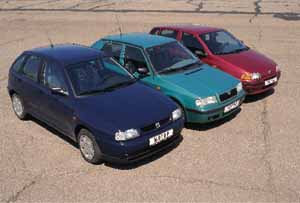 Everything is relative. In the fairness of this old one, like the world, we were able to make sure again when we collected this test. The verdict will be like that. A clear leader in control of controllability among the above cars - Seat Ibiza. It is followed by two French cars - Peugeot 106 and Renault 19, then Koreans: Hyundai Accent and Kia Sephia. And, with an unexpectedly large margin, at the end of this improvised parade - Fiat Punto.
Everything is relative. In the fairness of this old one, like the world, we were able to make sure again when we collected this test. The verdict will be like that. A clear leader in control of controllability among the above cars - Seat Ibiza. It is followed by two French cars - Peugeot 106 and Renault 19, then Koreans: Hyundai Accent and Kia Sephia. And, with an unexpectedly large margin, at the end of this improvised parade - Fiat Punto. According to the convenience of the cabin, in front of Kia Sephia, Daewoo Nexia and Skoda Felicia. By some margin from them - Renault 19 and Seat Ibiza. The comfort of the rest is approximately at the same level. He is high or low - this can be argued endlessly. What is quite enough
Source: Magazine Motor

